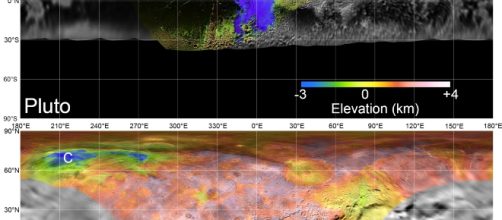NASA's New Flyover Movies of the Pluto system, created from New Horizons Spacecraft data and digital elevation models, give the sky-watching world close-up views of the spectacular features discovered on Pluto and Charon. Since the first New Horizons images came back in 2015 showing close-up pictures of the Pluto system — the dwarf planet Pluto and its moons, the largest of which is Charon — sky watchers have been eager for more.
New Horizons flyover movies
NASA's New Horizons mission scientists' two flyover movies reveal spectacular new features, seen from a closer vantage point than attained by the New Horizons spacecraft itself, reshaping how science understands Pluto and Charon.
The flyover movies show a hemispheric view of the dwarf planet and its moon. Pluto presents a longitudinal hemisphere, and Charon presents its northern hemisphere. The movies can be little dizzying, so a description of the flyovers is kindly provided by NASA.
Pluto's New Horizons flyover
Pluto's flyover covers a longitudinal hemisphere, going from north to southwest, back up north, then to southeast. Descending southward over the highlands, the flyover curves westward heading toward Pluto's western edge (the west edge, or limb, of a heavenly sphere is toward our earthly right while the east edge is toward our earthly left).
The New Horizons view crosses westward over the nitrogen ice plain, which contains blocky mountain ranges on its right and is bordered to the west by dark, cratered terrain.
The view turns north over the rugged and fractured highlands again. The view then turns southward over deep, wide pits then concludes over the sharply-bladed terrain of the eastern limb before seeming to fall off the southeast side into the approaching, vast canopy of stars.
All the names of features on Pluto and Charon are informal.
Let's add the informal names of Pluto's features seen on this hemisphere.
- Nitrogen ice plain, informally called Sputnik Planitia.
- Dark cratered terrain, called Cthulhu Macula.
- Highlands, rugged and fractured, called Voyager Terra.
- Sharply bladed terrain, called Tartarus Dorsa.
Charon's New Horizons flyover
Charon's flyover movie covers its northern hemisphere, soaring from equator to northern polar cap, then southward to equator again.
Charon's New Horizons movie begins at the equatorial belt, soaring over a surprising, elongated equatorial chasm. The flyover goes northward — showing a long shot of the equatorial chasm — over a wide, hollow crater, then over the dark polar hood.
The view turns southward again and cruises over rugged northern terrain, revealing a ringed pattern of hollowed areas looking rather like a flower with a raised center, toward the equator. The final view crosses over and concludes above the flat equatorial plain and the mystical "'moated mountains'" slightly south of the plain. Let's add the informal names of Charon's features seen on its northern hemisphere.
- Surprising elongated equatorial chasm, informally called Serenity Chasma.
- Northern crater, called crater Dorothy Gale.
- Dark polar hood, called Mordor Macula.
- Rugged northern terrain, called Oz Terra.
- Flat equatorial plains, called Vulcan Planum.
- Mystical moted mountains, called Clarke Montes.
Pluto and Charon have, thanks to NASA's New Horizons mission scientists, shown new faces and spectacular features to happy sky watchers.
Pluto and Charon flyover movies, the technicalities
The flyover movies have topographic relief features exaggerated in size "by a factor of two to three times" for enhancement of topographic detail, and the "surface colors of Pluto and Charon also have been enhanced" to provide greater detail.
NASA's Bill Keeter credits the work of Paul Schenk and John Blackwell of the Lunar and Planetary Institute in Houston: "Digital mapping and rendering were performed by Paul Schenk and John Blackwell of the Lunar and Planetary Institute in Houston. All feature names in the Pluto system are informal."
COOL ! New @NASA #Pluto & Charon flyover movies released by @NASA on 2nd anniversary of #PlutoFlyby ! pic.twitter.com/RV5yFJdNAO
— MONTAUD Andre pro (@MontaudPro) July 15, 2017


